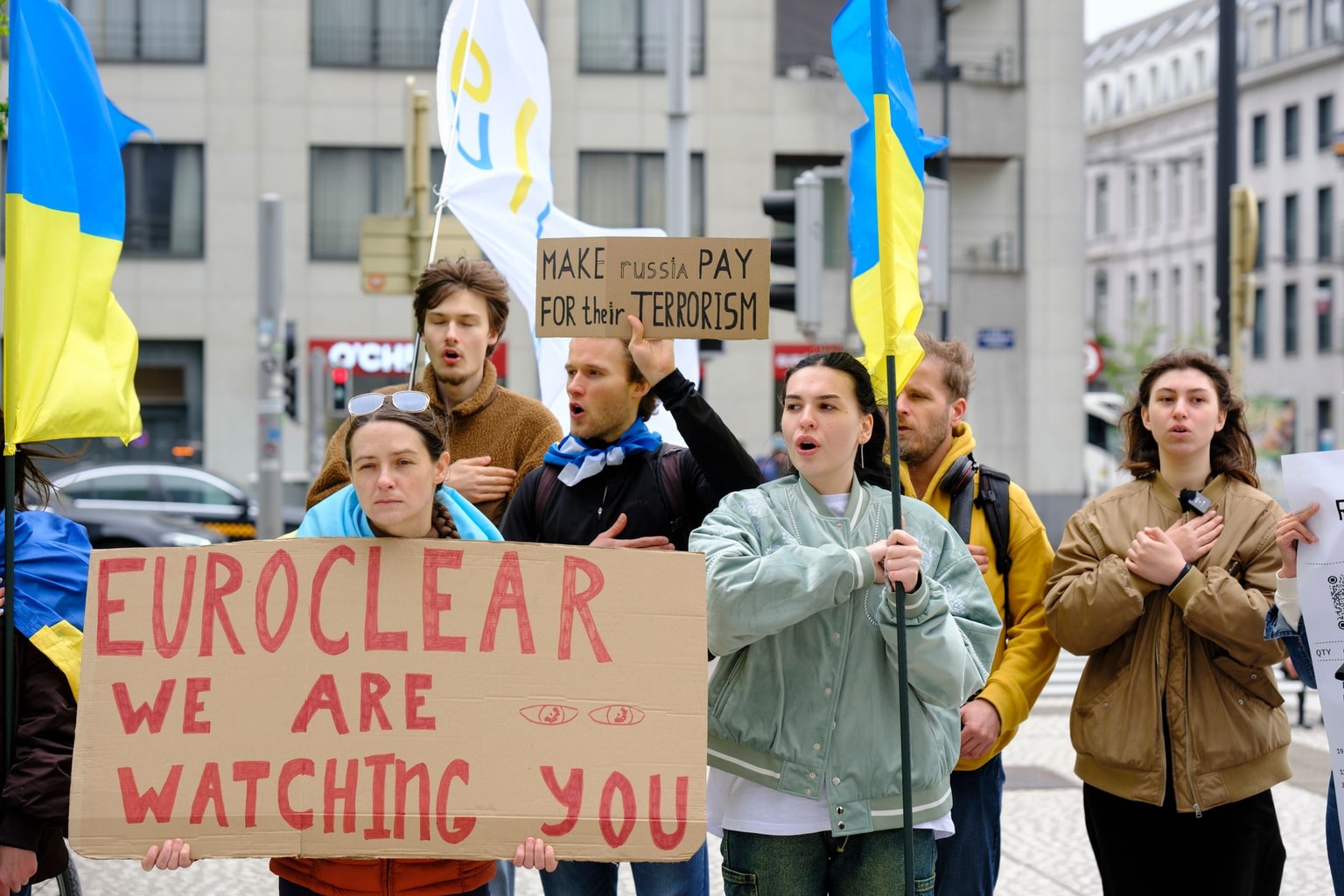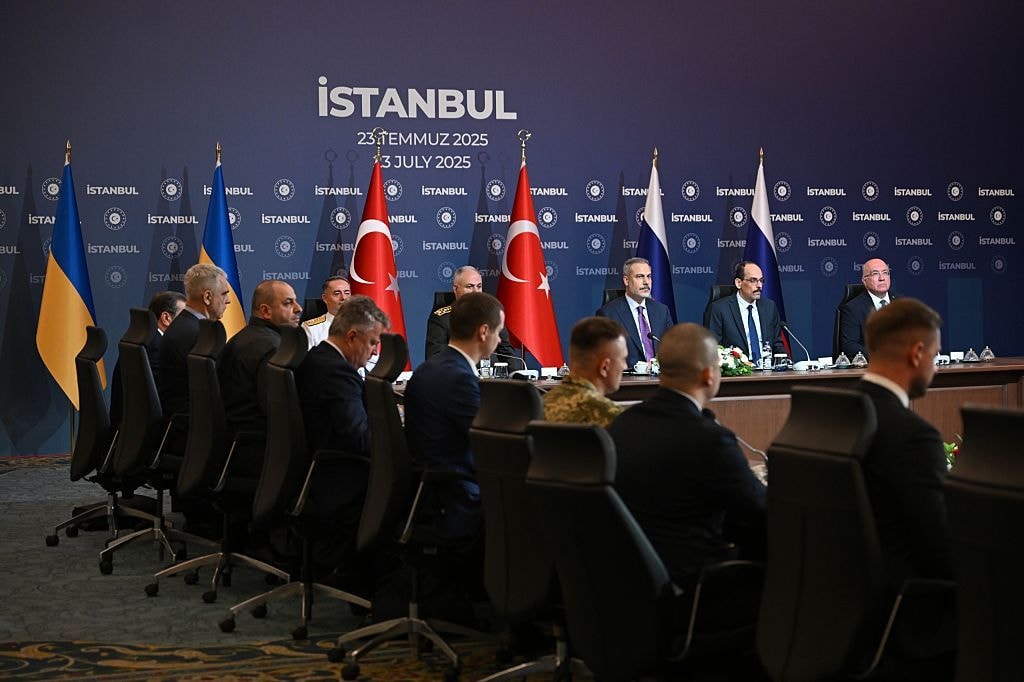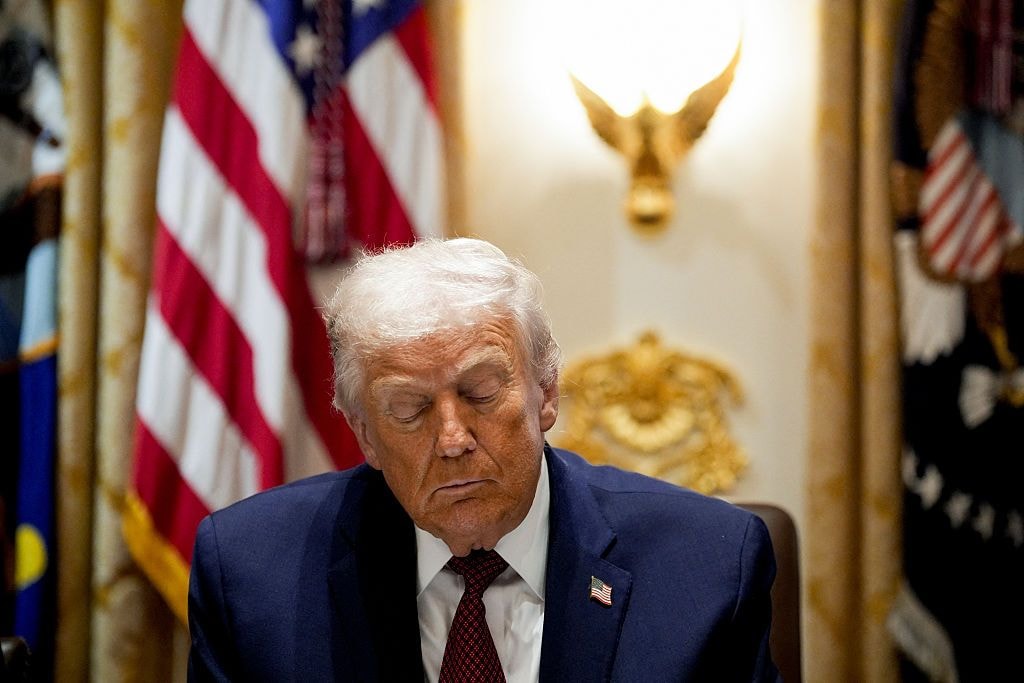
‘You have power, or you don’t:’ Ukraine’s energy crisis drives power decentralization
Ukraine wants to generate more energy in smaller amounts closer to users, rather than centralized facilities that are targets for Russian strikes. Though the war has created willpower to redesign the energy system, it has also created serious obstacles
An aerial drone view shows a local resident's plants next to a destroyed Russian tank, the remains of which lie in his garden in the village of Velyka Dymerka near Kyiv, Ukraine on May 17, 2023. (Maxym Marusenko/NurPhoto via Getty Images)
Decentralizing a power grid is a huge undertaking, even in peace times.
Countries around the globe are nevertheless shifting toward “decentralization” – or generating smaller amounts of energy closer to where it is used, rather than in large, centralized hubs. For most, the goal is producing greener energy or building grid resiliency in the face of climate disasters.
For Ukraine, however, Russian missile strikes that have crippled Ukraine’s grid have created an existential need to move energy production away from large facilities that have become targets for Russian attacks.
With Ukraine facing up to 20 hours of daily blackouts this winter, the country is looking to replace coal-powered thermal plants destroyed by Russian forces with new gas-powered turbines, solar panels, and “mini thermal plants,” among other efforts to decentralize as quickly as possible.
One consequence of the strikes on coal-fired plants is a forced reduction in carbon-based fossil fuel use: “Russia helped us to decarbonize much more quickly than we thought could work,” former lawmaker and political consultant on energy and climate Oleksii Riabchyn ironically noted, adding that this involuntary decarbonization can not be called sustainable.
Although the war has generated the willpower for a radical overhaul, it has also created serious obstacles to decentralization, including worker shortages, supply chain difficulties, struggles to find financing – and a fast-ticking clock before energy demand jumps in the winter.


This hasn’t stopped Ukraine from deploying new energy projects, but many are emergency solutions rather than part of a broader green strategy.
“Because we have to rush, we might end up with some mid-term problems after we do this decentralization. But we just have no choice,” said Olena Pavlenko, president and co-founder of DiXi Group, a Ukrainian energy think tank. “Ukraine should be allowed to make mistakes, because we are under huge pressure.”
Easier said than done
An energy infrastructure overhaul requires large amounts of capital, but investors are hesitant to invest in Ukraine because of security concerns and uncertainty about the future. Following Russia’s invasion in 2022, foreign direct investment dropped from $6.5 billion in 2021 to just $570 million in 2022, according to the Vienna Institute for International Economic Studies.
Fears around physical risk to assets are especially heightened in the energy sector due to Russia’s focus on destroying energy facilities.
Jakub Kucera, an asset manager at the Czech investment fund RSJ Investments, said that their firm has had to self-fund projects since the outbreak of the 2022 invasion because bank funding has been impossible to get.
The company, which has been building and investing in biomass heating systems in Ukraine since before the full-scale invasion, purchased its largest project in 2023 – a network of boiler houses in the Kyiv region for hospitals, schools, and kindergartens powered by wood chips and pellets.
Another problem is that sudden demand for independent heating systems has made boilers and other parts hard to find, while skilled workers who can design new projects are in short supply as well, according to Kucera, making new boiler projects unlikely to be operational by the upcoming winter.
“Now, everybody is talking about decentralization,” said Kucera, “but the problem is that it’s too late.”
The same supply and labor crunch is happening across the board in different energy sectors, including gas turbines and solar panels, said DTEK Executive Director Dmytro Sakharuk.

“You need to pay extra because there is a competition for installations, for procurement of solar panels, inverters and other spare parts needed,” Sakharuk said.
Low investment in Ukraine’s power grid has also contributed to the problem.
Experts point to Ukraine’s low electricity tariffs for households, which cap electricity prices for consumers below the cost to produce it. This has limited the ability for energy companies to reinvest in upgrading infrastructure.
“A greedy person always pays twice,” Sakharuk said. “Ukraine saved money during the last 10 years when we did not invest in upgrading the grid, and now we pay twice.”
Ukraine has already raised the tariff twice since the full-scale invasion began due to rising electricity prices and the cash-strapped government’s inability to maintain its steep subsidies.
The current standard price for households – about $0.11/kWh – is still around a third of the EU average. However, continuing to raise electricity prices is politically challenging during a war that has pushed almost 2 million Ukrainians into poverty.
Despite challenges and high costs, decentralization projects are still moving forward.
“Right now, the economics are not about differences between the price (of energy) from the grid, or from solar, let’s say,” Sakharuk said. “The difference is between two extremes: You have power, or you don’t.”
‘The emergency solution’
Earlier this month, Prime Minister Denys Shmyhal announced decentralization as one of the country’s five key areas of focus for the energy sector.
Among the initiatives expected to be in place by July 25 are compensation and loans for installing alternative energy sources, tax breaks for imports on energy equipment, and reducing red tape for new connections to the power grid.
These changes are aimed at further encouraging efforts to distribute energy production from the public, private, and nonprofit sectors, all of which have taken steps to decentralize since the outbreak of the full-scale invasion.
The state-owned oil company Ukrnafta recently announced that it is investing a billion dollars to build gas-powered energy generation over the next three years.
Even companies traditionally outside of the energy sector have been investing in gas-powered energy to improve resiliency and reduce dependence on unstable national grids. The national railway company Ukrzaliznytsia, the private postal service Nova Poshta, and even the sweets-producer Vatsak Confectionary House are among companies that have been investing in gas-powered generation.
Renewable energy projects have taken off as well. The Energy Ministry announced on July 2 that it had received 5,876 solar panels to power hospitals, as part of an agreement with the European Commission.
Hybrid systems, which integrate solar power, battery storage, and existing energy grid infrastructure, can bridge the gap between when a blackout begins and a hospital’s generator kicks in.
“If surgery is going on, you cannot pause the systems that circulate the blood or the air or the lungs per person for two minutes,” said Yuliana Onishchuk, founder of Energy Act for Ukraine Foundation, a charity organization that has been installing hybrid solar systems at hospitals and schools since just after the start of the full-scale invasion.
While solar panels may not be able to cover the entire hospital’s operations, they can prioritize “surgery rooms, intensive care units, maternity units, and basically all life-saving equipment,” Onischchuk explained.
Western partners in particular have advocated for greener energy solutions but recognize that there is a push and pull between rebuilding quickly and rebuilding green.
“The question is, how can the country rebuild its power generation as quickly as possible, and how much can be done before next winter season?” said Grzegorz Zielinski, head of Energy Europe for the European Bank of Reconstruction and Development (EBRD), in comments provided to the Kyiv Independent.
EBRD is providing support for Ukrnafta’s plans to build gas-piston and gas-turbine energy-generating facilities.
“If gas engines can be connected in the next 3-4 months, that’s the emergency solution,” he said. Although it is investing in gas power in Ukraine, the bank’s main focus and medium-term goal is still to invest in renewables, he added.
‘Now they are coming to us’
Volodymyr Shmatko was focused on renewables even before he took office as mayor of the western Ukrainian city Chortkiv in 2015.
As mayor, Shmatko, who has a degree in ecology, began touring other cities in Ukraine and abroad to see how their energy infrastructure worked and learn how to build a more sustainable energy system.
By 2018, Chortkiv had announced an ambitious plan to fully transition to renewable energy by 2050. The city has installed hybrid solar stations and regularly hosts events to educate its citizens about energy conservation. It now expects to generate around 30% of its energy from renewable sources by the end of the year, Shmatko said.

“In 2016 and 2017, we traveled to large cities in Ukraine and abroad to see what (their systems) are like and how they work. And now, in the last two or three months, they are coming to us,” he told the Kyiv Independent.
Cities that had already been working toward decarbonization and decentralization were better prepared when the Russian strikes began, Shmatko noted, because they had teams in place working on energy, alternative energy sources, experience making fast changes, and a network of contacts.
Shmatko hopes that other cities – even beyond Ukraine – can learn from Chortkiv’s experiences. In particular, he said high-quality reporting and transparent processes make it easier to attract partners and produce results.
“This is a very difficult time, this can be our shock therapy,” he said. “Why not try to be a leader?”












